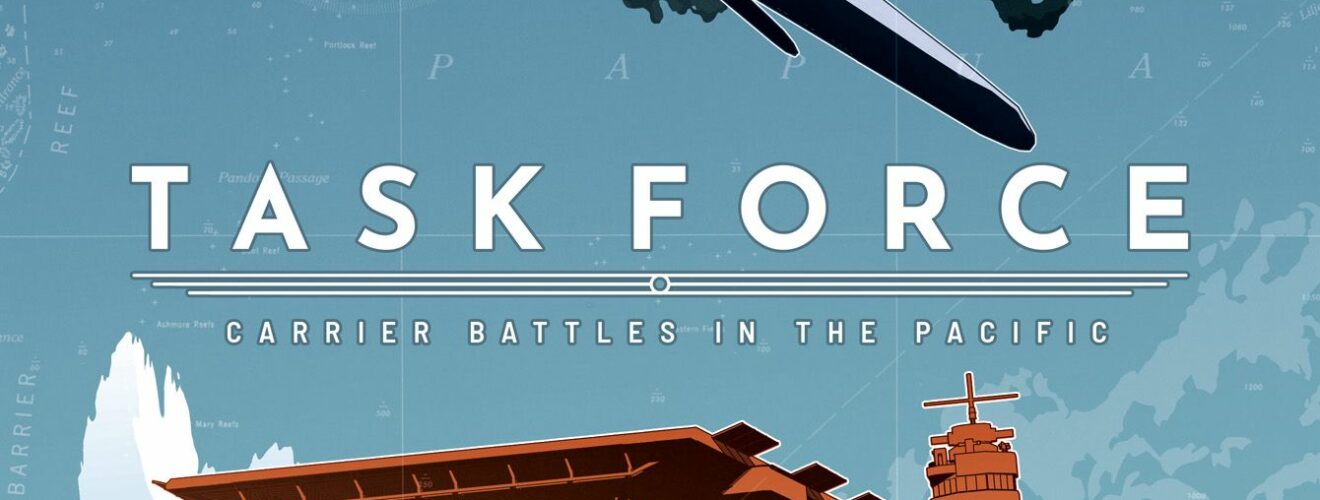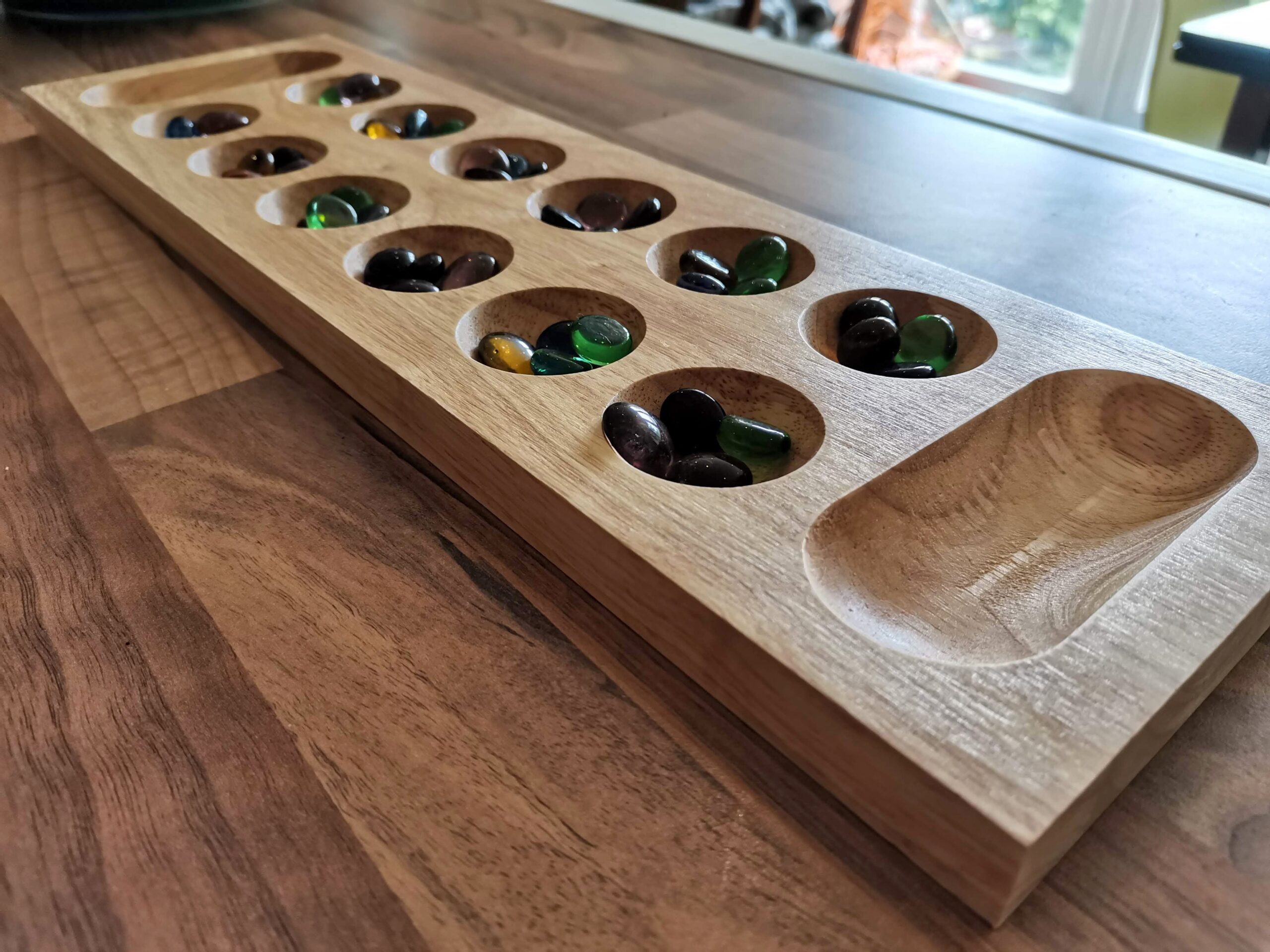Task Force: Carrier Battles in the Pacific Review

VUCA Simulations is a relatively new publisher, and one of the first games in its catalogue is this reprint of a pretty obscure 40-year-old game from a Japanese designer. Knowing this fact really piqued my interest. You don’t just pluck a random design from the ’80s and hope it’s a good one, so my assumption was that Task Force: Carrier Battles in the Pacific (I’m shortening that to Task Force for the rest of the review) was worth the effort. It turns out that I was right. Task Force was worth the effort. It’s a great system which simulates managing your fleets and aircraft carriers while trying to find your opponent’s in the middle of the ocean.

The first thing to note about Task Force is that it’s an operational-level game. You might command more than one task force during each scenario, but make no mistake that it’s the organisation of your various ships and vehicles that matters. I love the way the game gives each player a board to represent their task forces. There are spaces to identify which vessels belong to which task forces, but the real fun comes from the way you choose which aircraft on each carrier are in which position. It’s not a case of “drop a load of Zeroes on this boat and they can all fly off and fight”. Planes returning from missions can’t just join the front of the queue and take off again, which is great. It forces you to not only be careful with your choices, but also reinforces just how precious your carriers are. When carriers are attacked you roll a die (as you do to resolve most events in the game) which tells you if your planes on the deck, ready to take off, get destroyed. You’ll also determine whether the flight deck gets damaged, which can be a royal pain in the ass when you find out planes can’t take off any more, or worse still, you can’t land the planes you put in the air.
Made in Japan
The first thing that might strike you when you play Task Force is the apparent lop-sided balance. Things seem heavily weighted in Japan’s favour in a lot of places. You’ll take your US F4F fighters up against a squadron of Japanese Zeroes and notice that your planes’ individual 3 strengths are weak compared to the Japanese 5s, and right off the bat you’re looking at the Japanese player using the +2 column of the air-to-air combat table when they roll the die. When you take part in Naval combat, the IJN (Imperial Japanese Navy) always gets a +1 DRM (dice roll modifier). Always. While it seems really unfair, it’s just meant to reflect the difference in the experience of the two battling Navies. It’s not a game-breaking difference, and the balance in redressed in other places, but it’s enough to make you think twice about just charging in and trying to brute force your way through their lines.
If you’re reading this as an experienced wargamer, I don’t think there’s anything I’ve said so far that would cause any furrowing of brows. If you’re new to the genre, however, some of this could seem daunting. DRMs, consulting tables for attack resolution, air-to-air vs ship-to-ship combat. I mention this because VUCA positions Task Force as a game which newbies can enjoy, and I can see how you might not be feeling that so far in this review. It’s an important aim because as a board gamer who is still finding his way into wargaming, I’ve encountered a definite barrier to understanding with some things, so there’s a chance you might be struggling too. If the game is a soft, delicious crème brûlée, the unfamiliar terms and concepts are the hard, caramelised layer on the top.
Tutorials are to wargames as spoons are to crème brûlée. They help break through that hard layer to get to the yumminess lying in wait beneath. VUCA have done the equivalent of loads of smaller, softer crème brûlées in the box, so as to ease you in gently, with a series of easy-to-follow tutorials. It’s tasty stuff.

The tutorials are not as granular as the multitude of mini-lessons that Atlantic Chase used for its tutorials, but it certainly doesn’t throw you in at the deep end either. Being thrown in at the deep end when you’re on a carrier in the middle of the Pacific is a bad thing! I think the very first tutorial might be my favourite in any game, ever. That’s a bold claim, right? The first scenario is the attack on Pearl Harbour and it uses its own special map. It doesn’t even have the hexes which the rest of the game relies on. Instead, it gives you a very visual, easily-understood example of how air-to-surface combat works, completely bypassing any movement rules, and it’s a great way to ease you into things. Taking a specific scenario which even those ignorant of WWII may have an understanding of, and using a special layout which is included in the box for just this one scenario, goes to show just how much VUCA care about increasing accessibility and lowering the barrier to entry.
Cat & mouse
Much of the early game is similar to the aforementioned Atlantic Chase (review here). It’s a game of just trying to figure out where the heck the enemy task forces are. Each player has a cache of fleet marker tokens made up of some designating their task forces, while the rest are dummies. They all begin the game face-down, and each player has twelve tokens on the board. I love how reconnaissance is handled in this game. It’s not as simple as “My plane’s flown over here and it can see a carrier fleet”. Recon is handled by taking a token from a cup or bag and having your opponent look at it in secret, before telling you what the result is. ‘No contact’ is self-explanatory. The scout didn’t see anything. If the result is Detected, your opponent has to be honest with you. A dummy marker is shown if that’s what it was, otherwise, they’ll tell you it’s a carrier TF or a fleet TF.
That seems simple enough, but you can’t be sure they were telling the truth until you attack.

Why? Because there’s a chance you drew a Misdirect token. If that happens Dummies are reported to you as No Contact, carriers are reported as fleets, and vice-versa. The only thing you know for certain is probability and the knowledge that the Detected tokens outnumber the Misdirect tokens 5:2. So they’re probably telling the truth, but what if they aren’t? What if it was foggy when your recon pilots looked down, and they reported the wrong thing back? How certain are you? It’s a brilliant system, and the tension it builds is palpable. You’ll never know for certain until you either send in an air raid or engage in a naval battle, and I love it. It’s not just a case of a mechanism thrown in for the same of spicing up the gameplay, it’s thematic too. We’re talking about small planes making observations over the Pacific in the 1940s. Mistakes happened, I’m sure.
Thematic touches are all over the game’s design, and while they’re the sort of things wargame veterans might take for granted, newcomers – who VUCA have clearly invited to the party with Task Force – will be pleasantly surprised. Little things like nighttime phases altering the way things work. Things can change under the cover of darkness. Fleets can re-arrange themselves, ships can move further, and all ships can engage in combat, regardless of their range designations. Recon missions are a no-go, and you can’t even start one in the last two turns of a day, as the light fades. I really love the way any recon chits you have under a fleet marker get removed and thrown back into the draw cup during the night. It emphasises this feeling of “stuff happens in the dark that you can’t see”.
Final thoughts
Task Force: Carrier Battles in the Pacific is my first game from VUCA Simulations, and if it’s any kind of a marker for what to expect, it won’t be my last. It has the highest production values of any cardboard-based wargame I’ve played. The four double-sided map boards are really well-made, but the shining crown sitting atop its head is that every counter has rounded corners. That means no counter-clipping for the nearly 600 counters and tokens. Can you imagine?? More of this please, publishers. The rulebook and scenario book are really well written, with thorough examples every step of the way. There are a few grammatical errors which I’m sure are a result of translation, things like this excerpt from the section about applying damage – “and if the result is in the range of 1-3, the aircrafts on the flight deck are striken and explode”. It doesn’t really affect the readability or the understanding though, so I’m not about to give it a striken just for that, just be aware that it might not be 100% grammatically correct.
There’s a wonderful feeling of duelling throughout, helped no end by setting the game up with the map in the middle of the table, with each player sitting opposite and their fleet boards in front of them. Trying to find the task forces among the dummies is great. It’s like Battleships, but fun, and I love the way you can obfuscate things during the night turns. Combat is really easy to work through and the excellent player aids give you everything you need when it does all kick off in (or above) the ocean. There’s a decent selection of scenarios, including solo tutorials to help you teach your friends, and ratings of how difficult each scenario is. I’d be happy replaying any of the scenarios due to the sandbox nature of the gameplay, but if you do tire of them there’s a guide at the end explaining how to create your own scenarios, not to mention alternate orders of battle (OOBs) for the supplied scenarios.

I’m a long way from having any kind of authoritative experience in operational-level wargames, but Task Force: Carrier Battles in the Pacific strikes me as being an excellent example of how to do it well. It’s easy to learn, the rules are clear, and the graphic design and presentation throughout are superb. Fleet boards could so easily have been a sheet of card with rudimentary boxes printed on them but instead, they’re bi-fold mounted boards covered in illustrations. It’s just another seemingly small detail which makes the whole package feel a bit more accessible for newcomers. You might think I’m making too big a deal of a small thing, but I’m not. Things like this make a big difference. Task Force is awesome, and if it sounds like your sort of game (and you’re not bored of fighting the Battle of Midway for the hundredth time), then go out and get it. What a fantastic production.
Review copy kindly provided by VUCA Simulations. Thoughts and opinions are my own.

Task Force: Carrier Battles in the Pacific (2023)
Design: Ginichiro Suzuki
Publisher: VUCA Simulations
Art: Pablo Bazerque
Players: 1-2
Playing time: 45-90 mins













